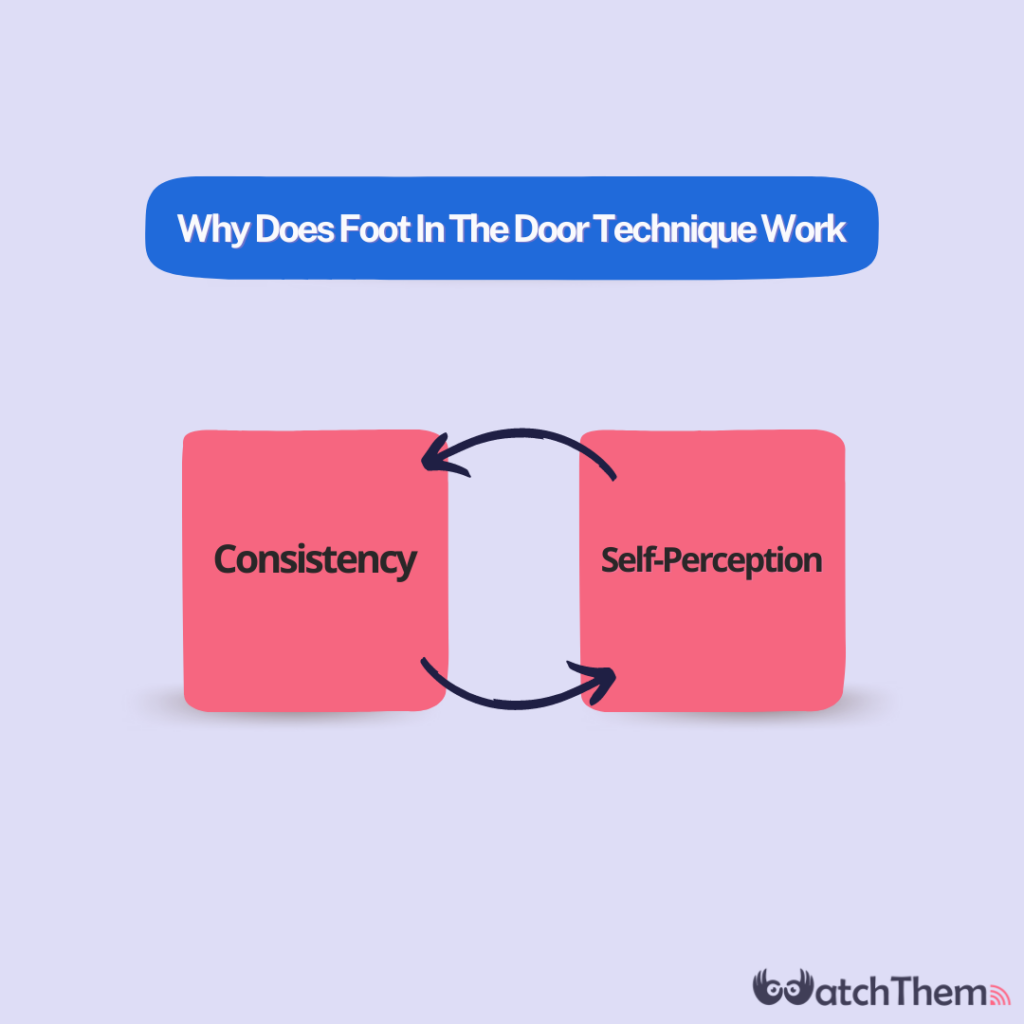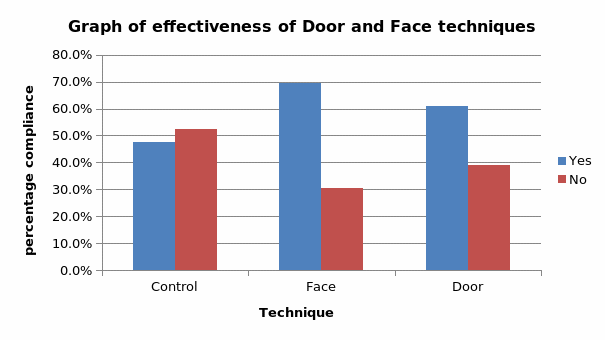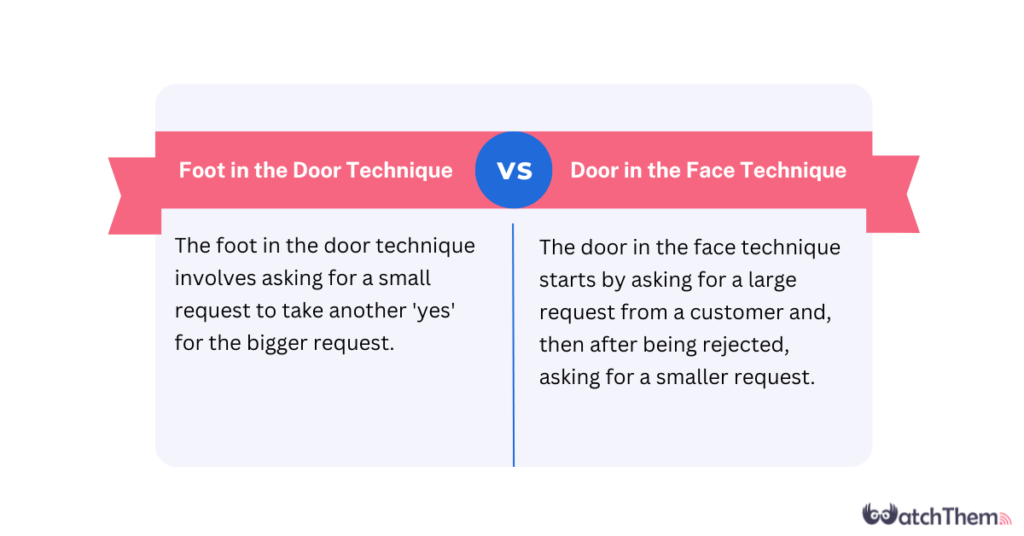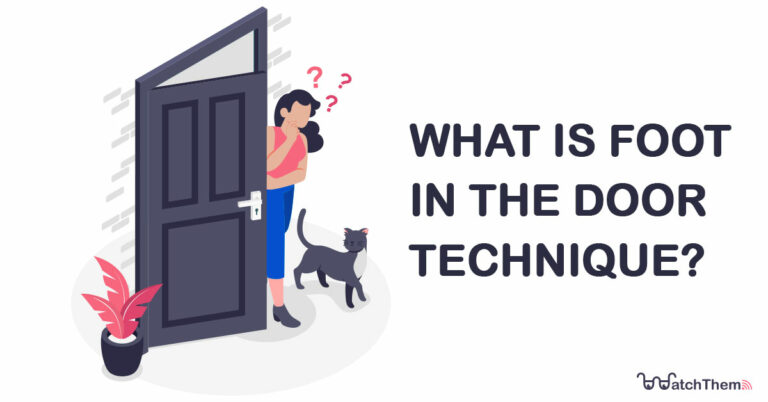Page Contents
How often have you been asked to taste a bite of chocolate or have a perfume sample while crossing a busy street? Did the sellers try to start a conversation with you, and minutes later, you bought things you didn’t need? Yes, all these miraculous events are part of the Foot in the Door Technique (FITD) used since the days of door-to-door salespeople.
Nowadays, with the rise of online marketing, business owners need to gather data about their target audience in order to be able to initiate this technique. That’s why website analytic tools are more popular than ever as they help you gather the necessary information for your business strategy.
Here we discuss the origins of this method and, of course, why you see yourself buying those stuff. By understanding what foot-in-the-door technique is and how it works, you can utilize this method yourself and increase your sales and revenue! Are you ready now? Let’s go!
What is Foot in The Door Technique
It is a method for convincing people to consent to a specific action. Using foot in the door technique, when a person complies with a small initial request, they will more likely agree to a second, more remarkable request or favor, which they would not have agreed to if they had been asked directly. Simple, right?
Let’s break it down a little. Foot in the door phenomenon (FITD) works by trying to receive a ‘YES’ first by asking a small favor. Then, getting the second ‘YES’ for the main bigger request wouldn’t be such a pain in the neck.
Here is how foot in the door technique works:
- First, start with a small request.
- After getting a YES, ask for something more significant or bigger, and you’ll see people are more likely to accept it.
This psychological trick can be discussed in depth in customer behavior analytics.
In traditional forms of marketing, marketers share their ads with a large audience, hoping that some of them are persuaded to buy their products or services. Of course, this form of advertisement doesn’t work anymore as the sea of consumers is much wider and expectations are higher.
Nowadays, businesses need to focus on their target audience and try to send personalized messages to them rather than targeting the whole population. For that, you need to know your audience and their needs and personalities. This way, the customers are more likely to convert and find the answer to their questions and needs through you. You’ll also save time and resources by focusing on the right audience. Now, imagine combining foot in the door phenomenon with your regular marketing techniques. The potential for conversion would be unbelievable. But does it actually work?
Keep reading to see some foot in the door phenomenon examples to help you better understand this mind-blowing technique!
Why Does Foot in The Door Technique Work
Well, now it’s time to discuss the reason behind buying stuff you don’t need on that busy street or on a website and how behavioral targeting can work in favor of companies. Psychologists have tried to explain how foot-in-the-door technique works and found two main reasons influencing it.


1. Consistency
Imagine you are in a clothing store, and the salesperson suddenly asks, ‘What color do you have in mind?’
By asking this simple question, they actually try to develop their relationship with you, and you see yourself honoring them.
This is basically the first foot in the door technique effect. Why? Since after this small question that you see no harm in answering, you probably agree with other offers due to the initial relationship you had already made with the salesman.
2. Self-Perception
Another factor influencing foot in the door phenomenon is the concept of self-perception. When a customer complies with the first request, since they feel the urge to suggest an acceptable picture of themselves, they are more inclined to consent to another offer. This way, they feel more pleased with the self-perception they create after saying the second ‘YES.’
Asking a small favor from your customer is just the first step of the foot in the door effect. After that, you need to optimize your sales funnel and guide your customers through every step of the journey so that they can convert easily.
History of Foot in The Door Technique
The research on foot-in-the-door phenomenon was first done by Jonathan Freedman and Scott Fraser in 1996.
In this study, some people were asked on the phone to talk about the type of cleaning products they used. Then, after a while, they were asked to let some people go to their houses and check their cleaning brands.
Surprisingly, the people who said ‘YES’ to the first request and had talked about their cleaning products were %135 more likely to say ‘YES’ to the second request.
Of course, other similar experiments regarding foot in the door technique proved Freedman and Fraser’s first hypothesis; That is, foot in the door effect is real!


How to Use Foot In The Door Phenomenon in Your Business Strategy
One of the most important factors you need to pay attention to is that the first request you ask of your customers should always be voluntary. If it’s not, it will no longer be the foot in the door technique, and customers won’t feel the need to be consistent with it.
In general, every action that relates customers to a past action is more likely to persuade them to answer a bigger request that you ask of them. But interestingly enough, even though relevant requests are proven to lead to more compliance, irrelevant requests also play a small part in foot in the door technique. Meaning that even when the first request is not completely relevant to your bigger one, customers are still more likely to accept it.
For example, CTAs are a great way to engage your customers and ask for their compliance. It’s engaging and easy!
You can also offer something valuable in return for every step they take such as updates and news, free plans, discounts, etc. By doing so, you can gain their trust and show them you care about their needs and are capable of fulfilling them.
What Are the Foot in The Door Technique Examples
We all know that the glory days of foot in the door technique have passed, the days when the door-to-door business model was the primary option, but in the online era, this method still works and has taken a new form. In the following, you can see some foot in the door phenomenon example.
1. Asking for an Email
In our modern days, the most common thing almost everyone has is an email. So it’s more likely that people will give away their email addresses to websites and businesses that ask for it, and this is the first ‘YES.’
For instance, using WatchThemLive, you can easily analyze your visitors’ behavior, see the type of device and browser they use, or even their locations, etc. This will allow you to send personalized emails to your target audience and gain their trust and interest.
Next, you can ask for their emails and then based on their behavior analysis, send them the news about your campaigns and new features and attract their attention to your business. From here, your business can sell products and take the second and third ‘YES’ too.
2. Charitable Donations
Imagine you run a charity. When asking for support, start with a small request like, ‘Would you be willing to sign a petition to support our cause?’ Once they agree, follow up with a larger request, saying, ‘Great! Now, would you consider making a small donation to help fund our activities?’
3. Asking to Share Their Experience on Social Media
Another foot in the door technique phenomenon example would be asking customers to share their experiences on social media to develop an initial relationship. It’s too easy for them to share a post or product on Twitter, Instagram, etc. This bridge is easy to build and maintain for receiving the second ‘YES.’
4. Sales Calls
In sales, try starting with, ‘Could I send you a free sample of our product?’ After they accept, proceed to the larger request, saying, ‘After trying the sample, would you be open to purchasing the full-sized product?’. By doing so, potential customers are more likely to say YES and accept your offer!
What Is the Difference Between Foot in the Door Technique & Door in the Face Technique
These two techniques may seem similar, but they are the exact opposite of each other. We discussed the foot-in-the-door phenomenon before and how persuading the clients to agree to your request leads you to the second and more important ‘YES.’


The door in the face technique works the other way around. Contrary to FITD, this technique starts by asking a large request from a customer or audience. This request is so demanding that the customer probably rejects it.
Then, another realistic offer is made. This time, the client may be more inclined to give their consent to the second request.
Let’s take a look at this door in the face technique example. If a platform tells you that they are selling a product for 10 times higher than the reasonable price, you will probably reject it. But then, when they reduce the cost to two times higher than normal, you’ll compare the two offers. Now, you are more likely to accept the second one because you think it’s more logical.
In fact, while the salesman reduces the price, you feel like you have to reply to their favor. So, you decide to buy that product or service. This occurs based on the reciprocity principle.
How Are Foot in the Door Technique And Sales Funnel Related
Online marketing is a highly competitive business structure. Customers research and compare you with your competitors before making the purchase and can easily change their minds and go to your rivals.
By using foot in the door technique, you can build a smooth and straightforward sales funnel and guide customers through each step by asking small requests that lead to bigger and more extensive ones.
This way, customers are less likely to abandon their progress. The most important step is funnel analysis and understanding where in your funnel, customers are dropping.
Foot in the Door FAQs
Now, let’s take a look at some frequently asked questions related to our topic.
#1 Foot in the Door Technique vs. Low-Ball Technique: What Is the Difference?
While the first technique starts with a small request and acts based on consistency and self-perception principles, the low-ball technique works based on the commitment principle.
How? First, the salesperson offers the customer a lower price but doesn’t intend to keep their promise. After the client makes up their mind to buy the service/product and gives the salesperson their consent, the salesperson tells them that there is a slight change in the cost due to a reason, for example, a mistake.
Since the buyer had agreed to the lower price, they usually feel committed to buying the product at a higher price as well. This is when a salesperson has used low-ball technique to persuade a buyer to purchase something.
#2 Is Foot in the Door Phenomenon Manipulation?
It’s a compliance tactic that persuades customers to consent to requests from business owners and salesmen. You may find yourself buying things you never wanted when someone uses this technique on you.
#3 What Is The First Step in Using Foot-In-The-Door Technique?
The first step is to ask your customers a small favor that they are more likely to accept and develop self-perception. This request must be voluntary and preferably, relevant to your niche.
#4 Does Foot in the Door Technique Work
As a well-known marketing strategy, foot in the door phenomenon is highly effective in persuading customers to purchase! It does so by asking a small request first. Then, the customer feels obliged to consent to the bigger request you ask of them.
As we mentioned earlier, it’s due to the consistency of requests and the self-perception the person develops after accepting the smaller request that they agree to a second, larger request.
Conclusion
Foot in The Door Technique may seem rude and intrusive, but, as Freedman and Fraser explained, it is a method of ‘compliance without pressure.’ In psychology studies of this method, it’s the customer who persuades him or herself. So you should be aware of this technique and use it if you desire.
In order to use this technique in your online business, you need to have a deep understanding of who your customers are and how they behave. WatchThemLive will help you keep track of your users and understand the ‘why’ behind their actions. So sign up for free now and start your journey right away!

